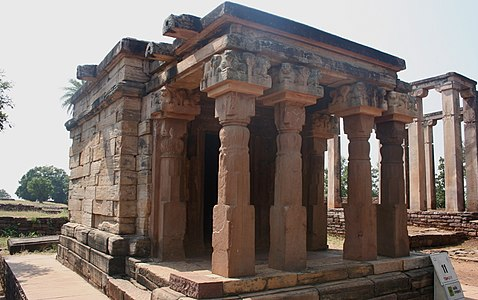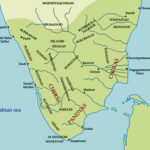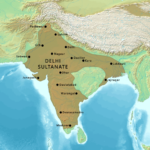>> In 4th Century AD a new dynasty, the Guptas, arose in Magadha and established a large kingdom over the greater part of Northern India (though their empire was not as large as that of the Mauryas). Their rule lasted for more than 200 years.
>>This period is referred as the ‘Classical Age’ or ‘Golden Age’ of ancient India and was perhaps the most prosperous era in the Indian history.
>> According to epigraphic evidence, the founder of the dynasty was a person named Gupta. He used the simple title of Maharaja.
>> Gupta was succeeded by his son Ghatotkach, who also inherited the title of Maharaja.
Chandragupta I : 319-334 AD
>> He was the first Gupta ruler to assume the title of Maharajadhiraja.
>> He strengthened his kingdom by matrimonial alliance with the powerful family of Lichchhavis who were the rulers of Mithila. His marriage to Lichchhvi princess Kumaradevi, brought to him enormous power, resources and prestige.
>>He started the Gupta Era in 319-20 AD.
>> Original type of Gold Coins (Dinaras): Chandragupta I-Kumaradevi type.
Samudragupta: 335-380 AD
>> Samudragupta was the greatest king of Gupta dynasty.
>> The most detailed and authentic record of his reign is preserved in the Prayaga Prasasti/ Allahabad pillar inscription, composed by his court poet Harisena.
>> Samudragupta’s military compaigns justify description of him as the ‘Napoleon of India’ by V.A. Smith.
>> Titles: Kaviraja i.e. king of poets (Prayaga Prasasti), Param Bhagavat (Nalanda copper plate), Ashvamedha-parakrama i.e. whose might was demonstrated by the horse-sacrifice (coin), Vikram i.e. prowess (coin), Sarva-raj-ochchettai.e. uprooter of all kings (coin) etc. Note: Only Gupta ruler had the title of Sarva-raj-ochehhetta.
>> Original types of Gold Coins (Dinars): Garud type, Dhanurdhari i.e. Archer type, Axe type, Ashamedha type, Vyaghrahanan i.e. Tiger killing type, Veenavadan i.e. lute playing type.
>> According to the Chinese writer Wang-Hiuen-Tse, Meghavarna, king of Sri Lanka, sent an embassy to Samudragupta for his permission to build a monastery for Buddhist pilgrims at Bodh Gaya.
Chandragupta II ‘Vikramaditya’: 380-414 AD
>> According to ‘Devi Chandragupta’ (Vishakhadatta), Samudragupta was succeeded by Ramgupta. It seems Ramgupta ruled for a very short period. He was ‘the only Gupta ruler to issue copper coins’.
>> Chandragupta Il extended the limits of empire by matrimonial alliances (with the Nagas and Vakatakas) and conquests (Western India). He married Kubernaga of Naga dynasty and married his daughter Prabhavatigupta with Vakataka prince Rudrasena II.
>> As a result of the overthrow of Saka rule in Western India, the Gupta empire extended upto Arabian sea. He issued silver coins in the memory of victory over Sakas. He was ‘the first Guptà ruler to issue silver coins’ and adopted the titles Sakari and Vikramaditya. Ujjain seems to have been made the second capital by Chandragupta II.
>> Mehrauli (near Kutub Minar, Delhi) Iron Pillar inscription says that the king defeated the confederacy of Vangas and Vahilkas (Bulkh).
>> Navaratna (i.e. nine gems) of Chandragupta II : 1. Kalidasa (Poetry-Ritusamhar, Meghadutam, Kumarsambhavam, Raghuvashama; Dramas-Malvikagnimitra, , Vikramorvashiyam, Abhijnan-Shakuntalam) 2. Amarsinh (Amarsinhkosha)3. Dhanavantri (Navanitakam-medicine text) 4. Varahmjhira (Panch Sidhantaka, Vrihatsamhita, Vrihat Jataka, Laghu Jataka) 5. Vararuchi (Vartika-a comment on Ashtadhyayi) 6.Ghatakarna 7. Kshapranak 8.Velabhatt 9. Shanku.
>> It was in Chandragupta’s time that the Chinese pilgrim Fahien visited India.
>>Titles: Devagupta/Devaraja/Devashri, Parama Bhagavata, Narendra
Chandra, Sinh Vikram etc.
>> Original types of Gold coins (Dinaras): Ashvarohi type, Chhatradhari type, Chakra-Vikram type etc.
Kumaragupta I : 415-455 AD
>> Chandragupta II was succeeded by his son Kumaragupta I.
>> Towards the end of his reign, the Gupta empire was threatened from the North by the Huns, who were temporarily checked by his son Skandagupta.
>> Kumaragupta was the worshipper of god Kartikeya.
>> He founded the Nalanda Mahavihara which developed into a great centre of learning.
>> Titles: Mahendraditya, Mahendra Sinh and Ashvamedha Mahendrah (coins) etc.
>> Original types of Gold Coins (Dinars): Khadgadhari type, Gajarohi type, Gajarohi Sinh-nihanta type, Khang-nihanta i.e. rhinoceros-slayer type, Kartikeya type, Apratigh-mudra type etc.
Skandagupta: 455-467 AD
>> Skandagupta, the last great ruler of the Gupta dynasty.
>> During his reign the Gupta empire was invaded by the Huns. He succeeded in defeating the Huns. Success in repelling the Huns seems to have been celebrated by the assumption of the title ‘Vikramaditya’ (Bhitari Pillar Inscription).
>> The decline of the empire began soon after his death.
>> Titles: Vikramaditya and Kramaditya (coins), Param Bhagavat (coins), Sharkropama (Kahaum Pillar Inscription), Devaraja (Arya Manjushri Mula Kalpa) etc.
state ownership of land)
Culture:
>> The architecture of the Gupta period may be divided into three categories:
- Rock-cut caves: Ajanta and Ellora Group (Maharashtra) and Bagh (MP).
- Structural Temples: Dasavatara temple of Deogarh (Jhansi district, UP)-the oldest and the best, Siva temple of Bhumra (Nagod, MP), Vishnu and Kankali temple (Tigawa, MP), Parvati temple of Nanchana- Kuthwa (Panna district, MP), Shiva temple of Khoh (Satna, Panna, MP), Krishna brick temple of Bhittargaon (Kanpur, UP), Laxman temple of Sirpur (Raipur, MP), Vishnu temple and Varah temple of Eran (MP).
- Stupas: Mirpur khas (Sindh), Dhammekh (Saranath) and Ratnagiri (Orissa).
>> By evolving the Nagara Style (Shikhar style), the Gupta art ushers in the history of Indian architecture. Shikhara Shrine, a Vaishnava symbol, one of the most characteristic features of temple architecture, found its fullest development during this period. The temple architecture, with its garbha griha (shrine room) in which the image of the god was placed, began with the Guptas.
>> The fragmentary remains of Dasavatara temple of Deogarh is the example of most ornate and beautifully composed Gupta temple building.
>> For the first time we get images of Vishnu, Shiva and other Gods.
>> Among the best specimen of the images of Buddha is a seated Buddha image of Sarnath, which depicts the Buddha preaching the Dhamma.
>> Of the Brahmanical images perhaps the most impressive was the Great Boar (Varah) carved in relief at the entrance of a cave at Udayagiri.
| Religious Literature |
| A. Hindu Texts: Some of the old religious books (viz. Vayu Purana, Vishnu Purana, Matsya Purana; Ramayan and Mahabharata, Manu Smriti) were re-written. Narad Smriti, Parashara Smriti, Bhrihaspati Smriti and Katyayana Smriti were written in this period. |
| B. Buddhist Texts: Abhidharma Kosha (Dignaga); Vishudhimagga (Buddhgosa) |
| C. Jain texts: Nyayavartam (Sidhsena) |
| Secular Literature |
| Ritusamhar (first poetry), Meghadutam, Kumarasam-bhavam, Raghuvamsam; Malavikagnimitra (first drama), Vikrammorvashi-yam, Abhijnana-Shakuntalam (Kalidasa); Mudrarakshasa (Visakhadatta); Kiratarjuniya (Bharavi); Kavyadarsa, Dasa Kumar Charita (Dandin); Mrichchhakatika (Sudraka); Panchatantra (Vishnu Sharma); Kamasutra (Vatsyayan) |
| Scientific Literature |
| Aryabhatiya, Surya Sidhant (Aryabhatta); Brahmasidhanta (Brahmagupta); Pancha Sidhantaka, Vrihat Samhita, Vrihat Jataka, Laghu Jataka (Varahmihira); Ashtanga Hridaya (medicine) (Vaghbatta); Navanitakam (Dhanvantri); Mahabhaskarya, Laghubaskarya (Bhaskara); Hastyayurveda (Palkapya) |
Note:
- ‘Manusmriti’ was translated in English under the title of ‘Institutes of Hindoo Law by William Jones.
- ‘Abhijnana Shakuntalam (i.e. recognition of Shakuntala) was translated in English by William Jones.
- Kalidas is known as ‘the Shakespeare of India’.
Featured Image Courtesy: universalinstitutions



